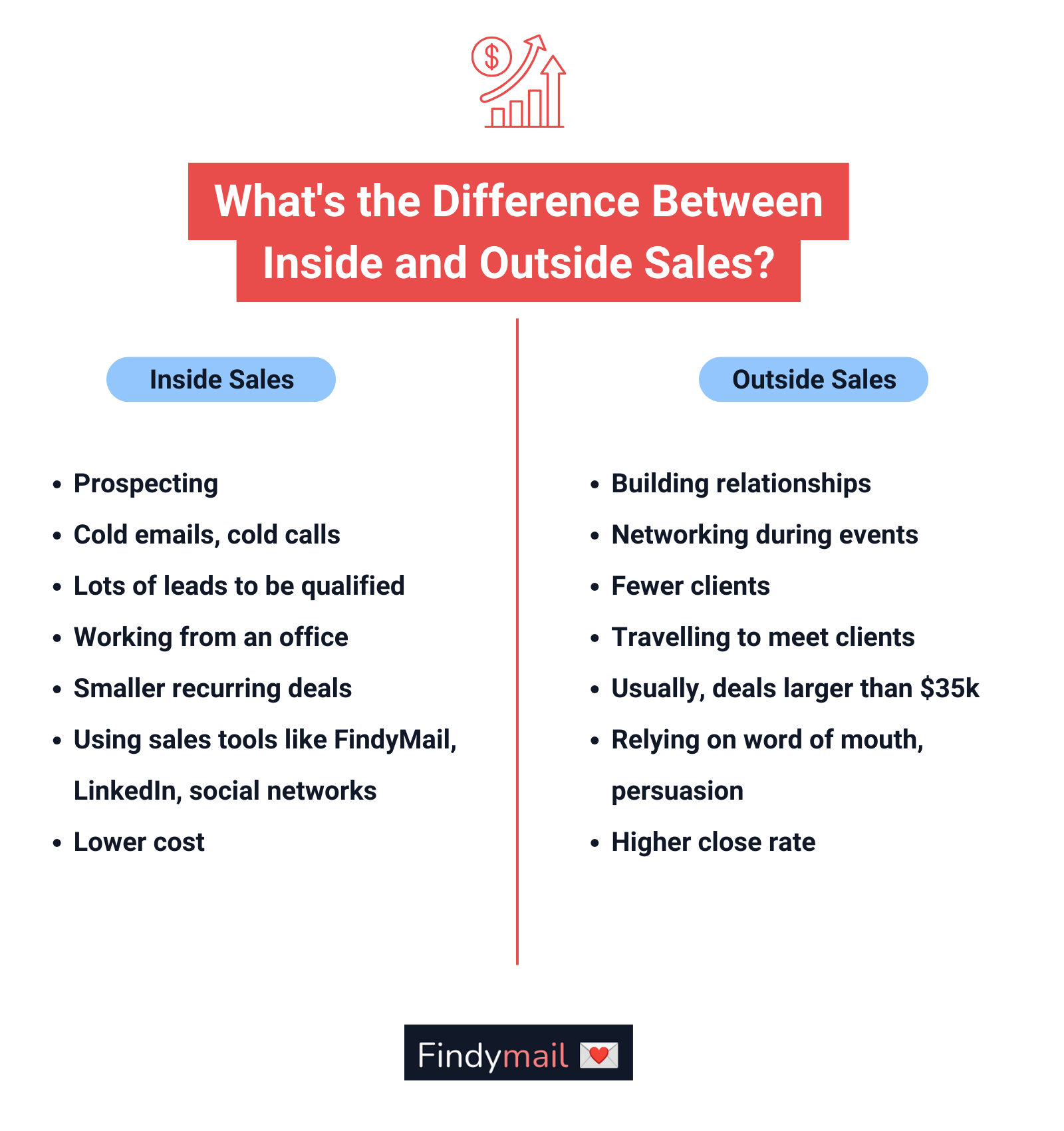At some stage or another, most businesses will need to decide if they’ll use inside or outside sales to sell their product and services or generate revenue. The problem is that many companies and sales reps don’t know the significant differences between inside vs. outside sales.
So, in this post, we’ll show you everything you need to know about inside vs. outside sales, from each type’s revenue potential to day-to-day activities.
Inside vs. Outside Sales
What Are Inside Sales?
Inside sales are activities when sales reps sell products or services to customers through email, phone, or other digital channels like social media. This means they sell to customers remotely instead of doing it face-to-face. That’s also why it’s called inside sales – these reps sell from inside an office or call center.
This approach does offer some advantages:
- Flexibility. Inside sales offer reps far more flexibility compared to outside sales. For instance, inside sales reps can work from anywhere and use several communication channels to sell to customers, including sales calls.
- Faster response times. Once inside sales reps get a lead, they don't need to schedule a meeting and travel to meet with the customer. This allows them to respond to leads faster.
- Reduced costs. With inside sales, every contact with a lead costs less. In turn, this reduces the cost of every sale and acquisition.
- Shorter, more efficient sales cycles. Inside sales typically have a shorter sales cycle because sales reps respond faster to leads. Inside sales also usually involve lower-priced products, which tend to sell faster.
What Are Outside Sales?
In contrast to inside sales, outside sales require that your sales reps leave the office and meet with customers in person. As such, outside sales reps need to travel to meetings and spend far less time at the office. This is also why outside sales are often referred to as field sales.
Like inside sales, outside sales also offer certain benefits:
- More valuable relationships. Because outside sales reps meet with customers in person, they can develop more profound, personal relationships with their customers. This allows sales reps to offer better solutions to their customers' problems; and leads to higher customer retention rates.
- More revenue. In contrast to inside sales, outside B2B sales involve higher-priced products. And when you can sell more expensive products, you'll increase your profit margins and generate more revenue. Plus, some reports find that outside sales professionals earn 14% more than inside sales pros.
- Higher close ratio. Finally, because outside sales reps meet with customers in person and build more valuable relationships, they typically close more deals than their inside sales counterparts.
- Uncertain post-COVID-19 future. While outside sales are rebounding, more and more teams are switching to hybrid sales.
Inside vs. Outside Sales: The Workflows
Now that we’ve seen the fundamentals, let’s look at what inside and outside sales reps do on a daily basis.
Inside sales reps focus a lot of their time and attention on finding leads. They do this by using several methods. For example, they could use an email finder like Findymail to get email addresses for their LinkedIn leads and spend their time reaching out to them.
As we've said earlier, this mostly happens through email, phone, or other digital channels. Finally, once they've interacted with these leads, inside sales reps record all the details of their interactions and sales pipelines in a CRM system.
Conversely, outside sales reps have entirely different workflows and responsibilities. They spend most of their time traveling and meeting with customers. During these meetings, they build and nurture relationships with high-value buyers.
In fact, if they don't build these relationships, they'll struggle to close deals and meet their quotas. In addition, outside sales reps also need to manage their sales territories to make as many sales as possible.

The Differences Between Inside vs. Outside Sales
Based on the broad overview above, we can now look at the differences between inside and outside sales in more detail.
Location
Location, or where the sale takes place, is the most significant difference between inside and outside sales reps, so much so that it’s reflected in their names. While inside sales jobs involve selling remotely, outside sales involve sales through in-person meetings. Both these result in an entirely different sales experience and customer expectations.
Sales Cycles
Outside sales typically have a longer sales cycle than inside sales. As mentioned earlier, this is because of a few reasons. For one, outside sales reps often sell more expensive products requiring different approval levels, which naturally take longer to sell.
Also, scheduling and attending in-person meetings takes more time than speaking to customers over the phone or email.
Sales Activities
Inside reps focus on gathering leads and closing sales, while outside sales reps have more extensive responsibilities, including territory management, attending meetings, and more.
Close Ratio
Inside sales reps typically have a lower close ratio than outside sales reps. This is because they’re focused on contacting as many leads as possible, so lead quality can fall by the wayside. In turn, outside sales reps are typically provided with higher quality leads and meet in person, which further increases the possibility of closing the deal.
Revenue Potential
Because inside sales reps sell lower-priced products compared to outside sales reps, they typically generate less revenue than outside sales reps. Keep in mind, however, that inside sales also have a far lower cost per sale than outside sales.
Inside vs. Outside Sales: Which Approach is Best?
Now, the question is: Which approach is best?
Ultimately, this is a question that every business or sales rep should answer based on their unique circumstances. Outside sales offer a higher revenue potential, but the stakes are higher, too. Conversely, inside sales are perfect for lower-priced products with more lead-generation activities.






